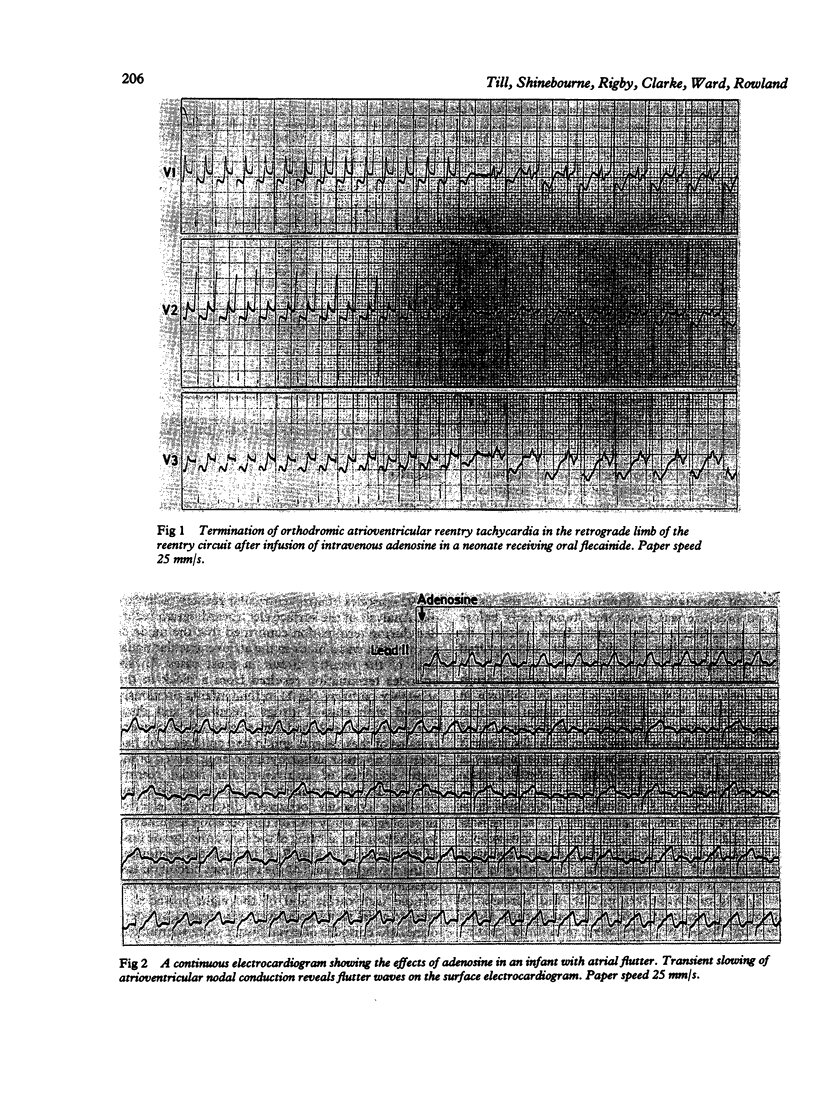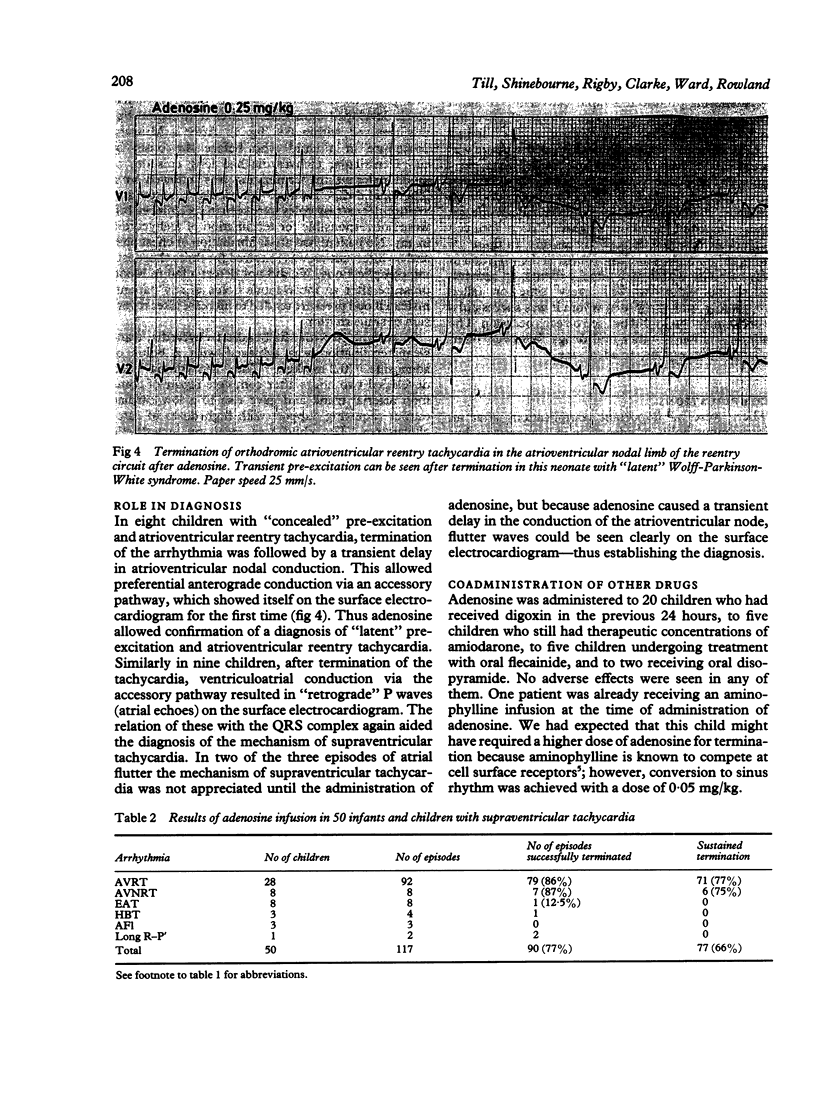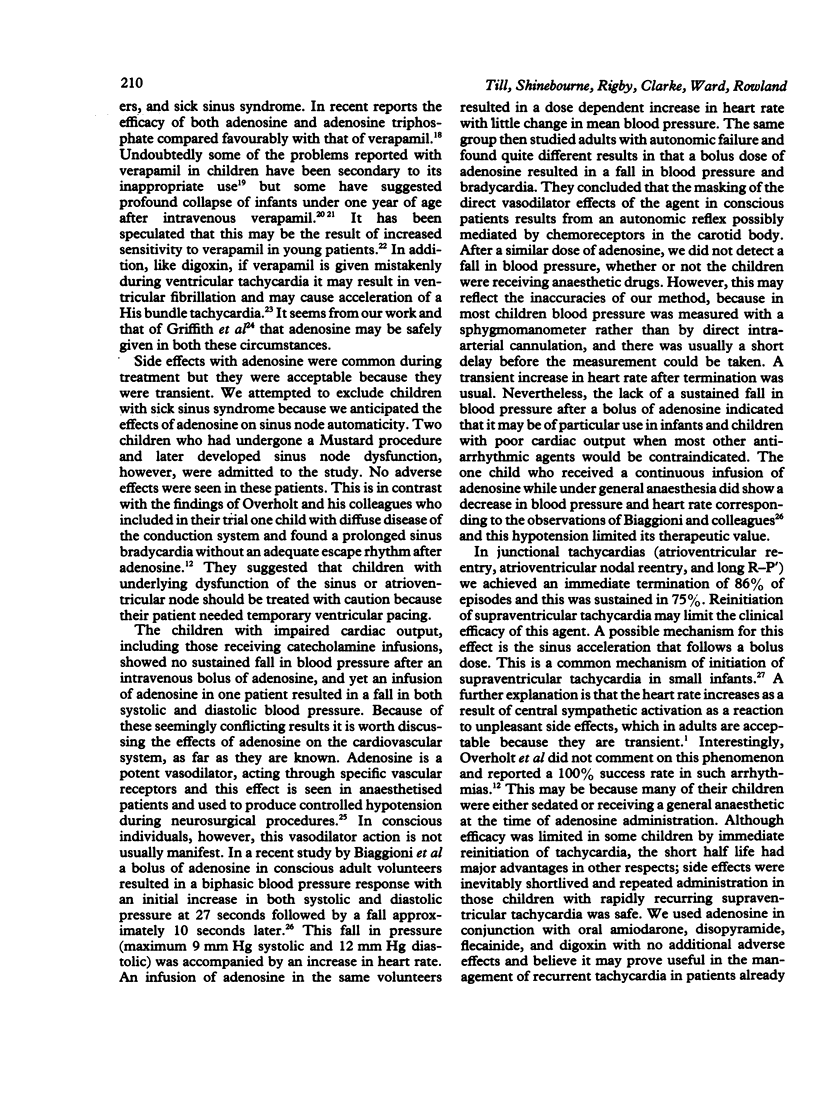Abstract
One hundred and seventeen episodes of supraventricular tachycardia in 50 children, including 28 infants, were treated with intravenous adenosine. Adenosine was prepared in a sterile solution of 0.9% saline (1 mg/ml) and given in incremental doses of 0.05 mg/kg every two minutes to a maximum of 0.25 mg/kg. Ninety of the 117 episodes were terminated. This included 88 of the 102 episodes of junctional tachycardia (79 of the 92 episodes of atrioventricular reentry tachycardia, seven of the eight episodes of atrioventricular nodal reentry tachycardia, and both of the episodes of long R-P' tachycardia). Only one of four episodes of His bundle tachycardia and one of the eight episodes of ectopic atrial tachycardia were terminated. None of the three episodes of atrial flutter were terminated. Side effects were frequent but mild and included transient complete atrioventricular block (less than 6 s), sinus bradycardia (less than 40 s), ventricular extrasystoles, flushing, nausea, headache, and respiratory disturbance. Reinitiation (within 5 s) of supraventricular tachycardia occurred in 13 of the terminated episodes. Although reinitiation limited its clinical efficacy in some patients, intravenous adenosine offered a safe and efficient method of rapid termination of most episodes of supraventricular tachycardia and in some cases facilitated diagnosis of the mechanism.
Full text
PDF







Images in this article
Selected References
These references are in PubMed. This may not be the complete list of references from this article.
- Belardinelli L., Fenton R. A., West A., Linden J., Althaus J. S., Berne R. M. Extracellular action of adenosine and the antagonism by aminophylline on the atrioventricular conduction of isolated perfused guinea pig and rat hearts. Circ Res. 1982 Nov;51(5):569–579. doi: 10.1161/01.res.51.5.569. [DOI] [PubMed] [Google Scholar]
- Belhassen B., Glick A., Laniado S. Comparative clinical and electrophysiologic effects of adenosine triphosphate and verapamil on paroxysmal reciprocating junctional tachycardia. Circulation. 1988 Apr;77(4):795–805. doi: 10.1161/01.cir.77.4.795. [DOI] [PubMed] [Google Scholar]
- Belhassen B., Pelleg A. Electrophysiologic effects of adenosine triphosphate and adenosine on the mammalian heart: clinical and experimental aspects. J Am Coll Cardiol. 1984 Aug;4(2):414–424. doi: 10.1016/s0735-1097(84)80233-8. [DOI] [PubMed] [Google Scholar]
- Benson D. W., Jr, Dunnigan A., Benditt D. G., Thompson T. R., Narayan A., Boros S. Prediction of digoxin treatment failure in infants with supraventricular tachycardia: role of transesophageal pacing. Pediatrics. 1985 Feb;75(2):288–293. [PubMed] [Google Scholar]
- Biaggioni I., Olafsson B., Robertson R. M., Hollister A. S., Robertson D. Cardiovascular and respiratory effects of adenosine in conscious man. Evidence for chemoreceptor activation. Circ Res. 1987 Dec;61(6):779–786. doi: 10.1161/01.res.61.6.779. [DOI] [PubMed] [Google Scholar]
- Bär F. W., Brugada P., Dassen W. R., Wellens H. J. Differential diagnosis of tachycardia with narrow QRS complex (shorter than 0.12 second). Am J Cardiol. 1984 Sep 1;54(6):555–560. doi: 10.1016/0002-9149(84)90247-9. [DOI] [PubMed] [Google Scholar]
- Clarke B., Till J., Rowland E., Ward D. E., Barnes P. J., Shinebourne E. A. Rapid and safe termination of supraventricular tachycardia in children by adenosine. Lancet. 1987 Feb 7;1(8528):299–301. doi: 10.1016/s0140-6736(87)92027-7. [DOI] [PubMed] [Google Scholar]
- Dunnigan A., Benditt D. G., Benson D. W., Jr Modes of onset ("initiating events") for paroxysmal atrial tachycardia in infants and children. Am J Cardiol. 1986 Jun 1;57(15):1280–1287. doi: 10.1016/0002-9149(86)90205-5. [DOI] [PubMed] [Google Scholar]
- Epstein M. L., Kiel E. A., Victorica B. E. Cardiac decompensation following verapamil therapy in infants with supraventricular tachycardia. Pediatrics. 1985 Apr;75(4):737–740. [PubMed] [Google Scholar]
- Garson A., Jr Medicolegal problems in the management of cardiac arrhythmias in children. Pediatrics. 1987 Jan;79(1):84–88. [PubMed] [Google Scholar]
- Greco R., Musto B., Arienzo V., Alborino A., Garofalo S., Marsico F. Treatment of paroxysmal supraventricular tachycardia in infancy with digitalis, adenosine-5'-triphosphate, and verapamil: a comparative study. Circulation. 1982 Sep;66(3):504–508. doi: 10.1161/01.cir.66.3.504. [DOI] [PubMed] [Google Scholar]
- Griffith M. J., Linker N. J., Ward D. E., Camm A. J. Adenosine in the diagnosis of broad complex tachycardia. Lancet. 1988 Mar 26;1(8587):672–675. doi: 10.1016/s0140-6736(88)91476-6. [DOI] [PubMed] [Google Scholar]
- Kirk C. R., Gibbs J. L., Thomas R., Radley-Smith R., Qureshi S. A. Cardiovascular collapse after verapamil in supraventricular tachycardia. Arch Dis Child. 1987 Dec;62(12):1265–1266. doi: 10.1136/adc.62.12.1265. [DOI] [PMC free article] [PubMed] [Google Scholar]
- Overholt E. D., Rheuban K. S., Gutgesell H. P., Lerman B. B., DiMarco J. P. Usefulness of adenosine for arrhythmias in infants and children. Am J Cardiol. 1988 Feb 1;61(4):336–340. doi: 10.1016/0002-9149(88)90940-x. [DOI] [PubMed] [Google Scholar]
- Perelman M. S., Krikler D. M. Termination of focal atrial tachycardia by adenosine triphosphate. Br Heart J. 1987 Nov;58(5):528–530. doi: 10.1136/hrt.58.5.528. [DOI] [PMC free article] [PubMed] [Google Scholar]
- Shahar E., Barzilay Z., Frand M. Verapamil in the treatment of paroxysmal supraventricular tachycardia in infants and children. J Pediatr. 1981 Feb;98(2):323–326. doi: 10.1016/s0022-3476(81)80672-5. [DOI] [PubMed] [Google Scholar]
- Skovránek J., Ostádal B., Pelouch V., Procházka J. Ontogenetic differences in cardiac sensitivity to verapamil in rats. Pediatr Cardiol. 1986;7(1):25–29. doi: 10.1007/BF02315478. [DOI] [PubMed] [Google Scholar]
- Soler-Soler J., Sagristá-Sauleda J., Cabrera A., Sauleda-Parés J., Iglesias-Berengué J., Permanyer-Miralda G., Roca-Llop J. Effect of verapamil in infants with paroxysmal supraventricular tachycardia. Circulation. 1979 May;59(5):876–879. doi: 10.1161/01.cir.59.5.876. [DOI] [PubMed] [Google Scholar]
- Sollevi A., Lagerkranser M., Irestedt L., Gordon E., Lindquist C. Controlled hypotension with adenosine in cerebral aneurysm surgery. Anesthesiology. 1984 Oct;61(4):400–405. doi: 10.1097/00000542-198410000-00007. [DOI] [PubMed] [Google Scholar]
- Watt A. H., Routledge P. A. Adenosine: an importance beyond ATP. Br Med J (Clin Res Ed) 1986 Dec 6;293(6560):1455–1456. doi: 10.1136/bmj.293.6560.1455. [DOI] [PMC free article] [PubMed] [Google Scholar]
- diMarco J. P., Sellers T. D., Lerman B. B., Greenberg M. L., Berne R. M., Belardinelli L. Diagnostic and therapeutic use of adenosine in patients with supraventricular tachyarrhythmias. J Am Coll Cardiol. 1985 Aug;6(2):417–425. doi: 10.1016/s0735-1097(85)80181-9. [DOI] [PubMed] [Google Scholar]






